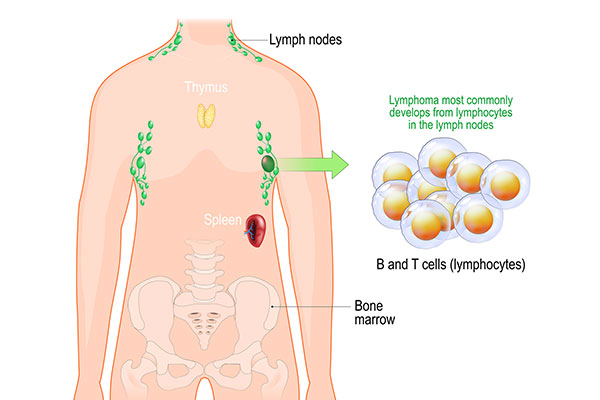Hodgkin Lymphoma in Children
What is Hodgkin lymphoma in children?
Hodgkin lymphoma (lim-FOE-muh) is a type of cancer that develops in the white blood cells of the lymphatic system. The lymphatic system is a part of the immune system and works to remove bacteria, viruses, and other harmful substances from the body.
The lymphatic system includes:
- Lymph: A fluid that contains lymphocyte cells.
- Lymph vessels: Tiny tubes that carry lymph fluid throughout the body.
- Lymphocytes: A type of white blood cell that fights infections and disease. Burkitt lymphoma grows from B-cells, a kind of lymphocyte.
- Lymph nodes: Small bean-shaped organs located in the underarm, groin, neck, chest, abdomen, and other areas. Lymph nodes filter lymph fluid as it moves around the body.
- Other organs and body tissues: The lymphatic system includes the bone marrow, the spleen, thymus, tonsils, and digestive tract.
Hodgkin lymphoma is a rare disease in children that causes abnormal growth of the cells in the lymphatic system. Over time, the body is less able to fight infection, and the lymph nodes swell. Hodgkin lymphoma cells can also spread (metastasize) to other organs and tissues. It affects boys more often than girls.
What causes Hodgkin lymphoma in a child?
The exact cause of Hodgkin lymphoma is not known. Genes and viral infections may increase the risk of having Hodgkin lymphoma.
Other causes include:
- Epstein-Barr virus, which causes mononucleosis (mono)
- HIV, the virus that causes AIDS
- Having a brother or sister with Hodgkin lymphoma
Symptoms of Hodgkin lymphoma in a child
Symptoms include:
- Painless swelling of the lymph nodes in the neck, underarm, groin, or chest
- Trouble breathing (dyspnea)
- Coughing
- Chest pain
- Fever
- Night sweats
- Fatigue
- Loss of appetite
- Weight loss
- Itching skin (pruritus)
- Frequent viral infections such as colds, flu, sinus infections
Make sure your child sees a pediatric provider for a diagnosis.
How is Hodgkin lymphoma diagnosed in children?
Your pediatric provider document your child’s medical history and current symptoms. They will examine your child and order some tests such as:
- Blood and urine tests
- Chest X-ray
- Lymph node biopsy
- A CT scan
- An MRI
- Positron emission tomography (PET) scan
- Bone marrow aspiration or biopsy
Staging treatment is a way to see if the disease has spread. This information helps the care team choose the best treatments.
- Stage I. The cancer is in a single lymph node region or organ.
- Stage II. The cancer is in two or more lymph node regions on the same side of the body, or cancer has spread from one lymph node into a nearby organ.
- Stage III. The cancer is in lymph node regions on both sides of the body. It also includes which organs and areas are involved.
- Stage IV. The cancer is in the lymphatic system and has spread to other body areas (metastasis).
Staging also includes whether a child has specific symptoms:
- Asymptomatic (A). No fever, night sweats, or weight loss.
- Symptomatic (B). Symptoms of fever, night sweats, or weight loss.
How is Hodgkin lymphoma treated in a child?
Most children with Hodgkin lymphoma are treated successfully and cured. Treatment will depend on the stage and other factors.
- Chemotherapy. These are medicines that kill cancer cells or stop them from growing. They are injected in the vein (IV), into the tissue, or taken by mouth.
- Radiation therapy. These are high-energy X-rays or other types of radiation. They are used to kill cancer cells or stop them from growing.
- High-dose chemotherapy with a stem cell transplant. Young blood cells (stem cells) are taken from the child or someone else. Stem cell transplants are followed by a large amount of chemotherapy medicine. This causes damage to the bone marrow. After the chemotherapy, the stem cells are replaced.
- Monoclonal antibodies. This is a type of targeted therapy that kills cancer cells without harming healthy cells.
- Supportive care. Treatment can cause side effects. Medicines and other treatments can be used for pain, fever, infection, nausea, and vomiting.
- Clinical trials. Ask your child’s pediatric provider if there are any clinical trials available.
Your child will need follow-up care during and after treatment to:
- Check your child’s response to the treatment
- Manage the side effects of treatment
- Look for returning or spreading cancer
Some treatments may be complicated but increase the chance of your child living a long time. Discuss the side effects of treatment with your child’s healthcare provider.


